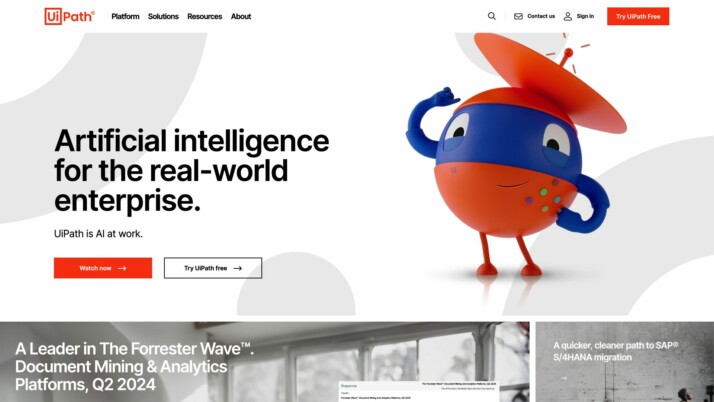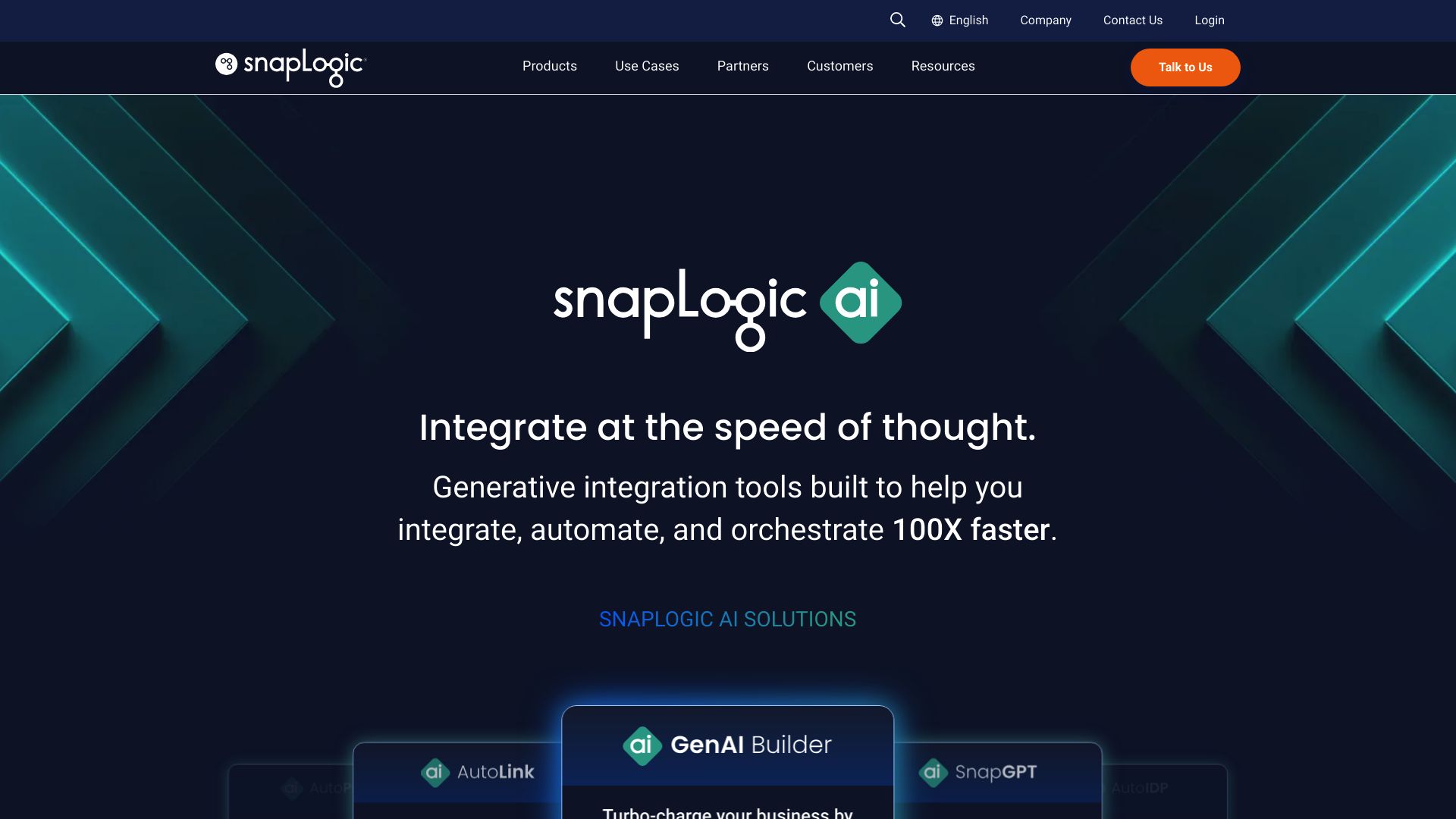UiPath vs. snapLogic AI: Comparing RPA and AI Integration Solutions
AI-powered automation platforms revolutionize business operations, promising unprecedented efficiency and innovation. UiPath’s robotic process automation and snapLogic AI’s intelligent integration solutions offer unique approaches to streamlining workflows and managing data. This comparison delves into their core features, strengths, and limitations, uncovering how each platform tackles enterprise challenges. We’ll explore UiPath’s focus on structured automation, snapLogic AI’s emphasis on AI-driven integration, and introduce SmythOS as a compelling alternative for businesses seeking advanced AI agent capabilities. By examining these platforms side-by-side, we equip decision-makers with crucial insights to select the ideal solution for their organization’s automation needs.
UiPath Overview
UiPath revolutionizes business process automation through its comprehensive robotic process automation (RPA) platform. The company’s flagship product, the UiPath Enterprise RPA Platform, empowers organizations to automate repetitive tasks, streamline workflows, and boost productivity across diverse industries.


At its core, UiPath’s offering combines powerful RPA capabilities with artificial intelligence to create intelligent software robots. These ’digital workers’ excel at executing rule-based processes, freeing human employees to focus on higher-value tasks. UiPath’s platform stands out for its versatility, catering to both technical developers and business users through intuitive visual interfaces and no-code options.
UiPath’s offering combines powerful RPA capabilities with artificial intelligence to create intelligent software robots. These ’digital workers’ excel at executing rule-based processes, freeing human employees to focus on higher-value tasks.
Key features of UiPath include UiPath Studio for visual workflow design, UiPath Orchestrator for centralized robot management, and UiPath Robots for task execution. The platform’s AI capabilities, integrated through UiPath AI Center, enable advanced document understanding, computer vision, and natural language processing. This combination of RPA and AI allows UiPath to tackle increasingly complex automation scenarios.
UiPath excels in enterprise-grade scalability and security, making it a top choice for large organizations with complex IT environments. The platform offers robust governance features, detailed audit logs, and seamless integration with existing systems. However, smaller businesses may find the extensive feature set overwhelming or cost-prohibitive compared to simpler alternatives.
While UiPath delivers impressive automation capabilities, it faces challenges in fully autonomous agent development. The platform primarily focuses on structured, rule-based processes rather than open-ended problem-solving. Additionally, UiPath’s learning curve can be steep for non-technical users, despite efforts to simplify the interface. As the RPA landscape evolves, UiPath continues to innovate, expanding its AI capabilities and exploring new frontiers in intelligent automation.
snapLogic AI Overview
snapLogic AI provides an Intelligent Integration Platform (IIP) that leverages AI-powered workflows to streamline IT integration projects. The platform automates design, development, deployment, and maintenance across on-premises, cloud, and hybrid environments. snapLogic’s user-friendly interface caters to both expert integrators and business users, enabling efficient management of application and data integration on a scalable platform.


The platform’s AI capabilities, including Iris AI technology, offer intelligent recommendations for building data pipelines with high accuracy. snapLogic supports integration across various data types and sources, using “Snaps” as connectors for seamless integration with SaaS and on-premises applications. The platform leverages Amazon’s Elastic Compute Cloud (EC2) infrastructure for scalable integration processes, optimizing computing power and data proximity.
snapLogic supports integration across various data types and sources, using “Snaps” as connectors for seamless integration with SaaS and on-premises applications.
Recent additions to snapLogic’s offerings include SnapGPT and GenAI Builder, tools that enable no-code development of AI applications. These innovations allow employees to create AI models and chatbots using natural language prompts, further democratizing AI development within organizations.
While snapLogic offers robust features for enterprise integration and AI-driven automation, it may not provide the same level of specialized AI agent development capabilities as some dedicated AI agent platforms. The focus on integration and workflow automation means that users looking for more advanced, autonomous AI agents might find the platform’s offerings somewhat limited in this specific area.
SnapLogic’s vision centers on simplifying enterprise system integration, democratizing data access, and accelerating digital transformation. By enabling users to automate business processes and integrate applications and data seamlessly, snapLogic aims to drive innovation and business growth through AI-led integration. However, organizations seeking highly specialized AI agent development might need to evaluate whether snapLogic’s integration-focused approach aligns with their specific AI agent requirements.
Feature Comparison
UiPath and snapLogic AI offer distinct approaches to automation and integration, with notable feature gaps in core components and security. UiPath excels in robotic process automation (RPA) with a focus on structured workflows, while snapLogic AI emphasizes AI-driven integration and data management.
In core components, UiPath provides robust tools for building and managing automation workflows through its Studio and Orchestrator platforms. However, it lacks native support for autonomous agents capable of open-ended problem-solving. snapLogic AI, on the other hand, offers AI-powered integration with its Iris AI technology, but falls short in providing comprehensive RPA capabilities comparable to UiPath.
Regarding security, both platforms offer data encryption and OAuth support. UiPath provides detailed audit logs and IP control mechanisms, enhancing its enterprise-grade security features. snapLogic AI leverages Amazon’s EC2 infrastructure for scalable and secure deployments but may not match UiPath’s granular control over robot permissions and activities. Neither platform fully addresses constrained alignment, leaving room for improvement in ensuring AI behavior aligns strictly with organizational goals and ethical guidelines.
Feature Comparison Table
| UiPath | snapLogic AI | SmythOS | |
|---|---|---|---|
| CORE FEATURES | |||
| AI Agents | ❌ | ✅ | ✅ |
| Hosted Agents (Dev, Production) | ❌ | ✅ | ✅ |
| No-Code Options | ❌ | ✅ | ✅ |
| Memory & Context | ❌ | ❌ | ✅ |
| Autonomous Agents | ❌ | ✅ | ✅ |
| Explainability & Transparency | ❌ | ✅ | ✅ |
| Multimodal | ❌ | ✅ | ✅ |
| Problem-Solving Capabilities | ❌ | ✅ | ✅ |
| Multi-Agent Collaboration | ❌ | ✅ | ✅ |
| Work as Team | ❌ | ✅ | ✅ |
| SECURITY | |||
| Constrained Alignment | ❌ | ✅ | ✅ |
| COMPONENTS | |||
| Foundation AIs | ❌ | ❌ | ✅ |
| Huggingface AIs | ❌ | ❌ | ✅ |
| Zapier APIs | ❌ | ❌ | ✅ |
| Classifiers | ❌ | ❌ | ✅ |
| Data Lakes | ❌ | ✅ | ✅ |
| DEPLOYMENT OPTIONS (EMBODIMENTS) | |||
| Deploy as API | ❌ | ✅ | ✅ |
| Deploy as Webhook | ❌ | ✅ | ✅ |
| Staging Domains | ❌ | ❌ | ✅ |
| Production Domains | ❌ | ❌ | ✅ |
| Deploy as Site Chat | ❌ | ❌ | ✅ |
| Deploy as Scheduled Agent | ❌ | ✅ | ✅ |
| Deploy as GPT | ❌ | ❌ | ✅ |
| DATA LAKE SUPPORT | |||
| Hosted Vector Database | ❌ | ❌ | ✅ |
| Sitemap Crawler | ❌ | ❌ | ✅ |
| YouTube Transcript Crawler | ❌ | ❌ | ✅ |
| URL Crawler | ❌ | ❌ | ✅ |
| TXT File Support | ❌ | ✅ | ✅ |
Best Alternative to UiPath and snapLogic AI
SmythOS emerges as the superior alternative to UiPath and snapLogic AI, offering a comprehensive platform for agentic AI automation. Our solution combines ease of use, an extensive feature set, and unlimited use cases, positioning it as the ideal choice for businesses seeking advanced AI capabilities.
We provide a user-friendly drag-and-drop interface that simplifies the creation of complex AI workflows, making it accessible to users with varying levels of technical expertise. This intuitive design philosophy extends throughout our platform, enabling rapid development and deployment of AI agents without extensive coding knowledge.
We offer autonomous agents with problem-solving capabilities, multi-agent collaboration, and support for multimodal interactions.
Our feature set surpasses both UiPath and snapLogic AI in critical areas. We offer autonomous agents with problem-solving capabilities, multi-agent collaboration, and support for multimodal interactions. These advanced functionalities allow for the creation of sophisticated AI systems that can handle complex tasks and adapt to diverse scenarios. Additionally, our platform includes memory and context management, ensuring agents maintain coherent interactions over time.
Unlike UiPath’s focus on structured RPA workflows or snapLogic AI’s emphasis on data integration, we provide a versatile platform that accommodates an unlimited range of use cases. From chatbots and API deployments to scheduled agents and GPT models, our solution adapts to various business needs. This flexibility, combined with our extensive integration options, including support for Zapier APIs and various AI models, enables businesses to create tailored AI solutions for any industry or application.
Security and scalability are paramount in our design. We implement constrained alignment to ensure AI behavior aligns with organizational goals and ethical guidelines, a feature not explicitly offered by UiPath or snapLogic AI. Our platform also provides robust data encryption, OAuth support, and IP control mechanisms, meeting enterprise-grade security standards while offering the scalability needed for growing businesses.
Conclusion
UiPath and snapLogic AI offer powerful automation solutions, each with distinct strengths. UiPath excels in robotic process automation, providing enterprise-grade tools for structured workflow design and management. snapLogic AI shines in AI-driven integration, leveraging intelligent recommendations to streamline data pipelines and application connectivity.
While both platforms deliver value in their respective domains, they fall short in key areas of autonomous agent development and advanced AI capabilities. UiPath’s focus on rule-based processes limits its ability to handle open-ended problem-solving, while snapLogic AI’s integration-centric approach may not fully satisfy organizations seeking specialized AI agent development.
SmythOS emerges as the superior choice for businesses looking to harness the full potential of AI agents. Our platform combines the best of both worlds – offering intuitive visual design tools alongside powerful AI capabilities. With SmythOS, you can create and deploy autonomous agents across multiple environments, from APIs to chatbots, without sacrificing flexibility or scalability.
We invite you to experience the future of AI automation with SmythOS. Explore our diverse range of AI-powered agent templates to jumpstart your projects, or dive into our comprehensive documentation to understand the full scope of our platform’s capabilities. Ready to transform your business with intelligent AI agents? Create a free SmythOS account today and start building the next generation of AI-powered solutions.
Last updated:
Disclaimer: The information presented in this article is for general informational purposes only and is provided as is. While we strive to keep the content up-to-date and accurate, we make no representations or warranties of any kind, express or implied, about the completeness, accuracy, reliability, suitability, or availability of the information contained in this article.
Any reliance you place on such information is strictly at your own risk. We reserve the right to make additions, deletions, or modifications to the contents of this article at any time without prior notice.
In no event will we be liable for any loss or damage including without limitation, indirect or consequential loss or damage, or any loss or damage whatsoever arising from loss of data, profits, or any other loss not specified herein arising out of, or in connection with, the use of this article.
Despite our best efforts, this article may contain oversights, errors, or omissions. If you notice any inaccuracies or have concerns about the content, please report them through our content feedback form. Your input helps us maintain the quality and reliability of our information.
